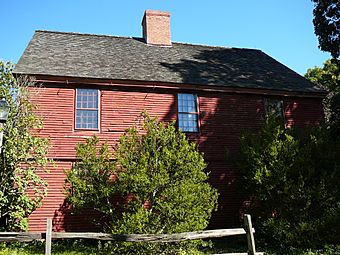Theophilus Jones House facts for kids
Quick facts for kids |
|
|
Theophilus Jones House
|
|
 |
|
| Location | 40 Jones Rd., Wallingford, Connecticut |
|---|---|
| Area | 1.8 acres (0.73 ha) |
| Architectural style | Colonial |
| NRHP reference No. | 91001981 |
| Added to NRHP | January 30, 1992 |
The Theophilus Jones House is a really old and special house in Wallingford, Connecticut. It was built around 1740, which makes it one of the oldest buildings still standing in the town! This house is also famous because it was carefully brought back to its original 1700s look in the 1940s by a man named Charles F. Montgomery. Because of its history and how well it was restored, it was added to the National Register of Historic Places in 1992.
Contents
Discovering the Theophilus Jones House
The Theophilus Jones House is located in a quiet neighborhood in Wallingford. It's a two-and-a-half-story building made of wood. It has a pointed roof and a big chimney in the middle. The outside is covered with wooden boards called clapboards.
What the House Looks Like
The front of the house has three sections. Windows are placed evenly around the main door. The second floor sticks out a little bit over the first floor. Windows on both levels are very close to the roof's edge. The front door has a simple frame and a window with many small panes of glass above it. Inside the house, you can find a mix of original parts, old pieces that were reused, and new parts made to look old.
A Glimpse into History
Theophilus Jones built this house around 1740. His grandfather, William Jones, was one of the first people to settle in the New Haven Colony. The house and the farm around it stayed in the Jones family for a very long time, until 1914. After that, the farmland was slowly sold off to build new homes.
The House's Big Makeover
In 1937, a man named Charles F. Montgomery bought the house. He was a very important expert on old American art and furniture. Montgomery lived in the house until 1950. During this time, he worked hard to restore the house. He wanted it to look just like it did in the 1700s. He removed many layers of paint and changes from the 1800s and early 1900s. He also made new parts that looked old and even moved some pieces around to match the original style.



